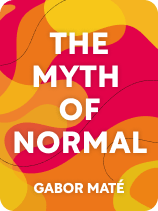

This article is an excerpt from the Shortform book guide to "The Myth of Normal" by Gabor Maté. Shortform has the world's best summaries and analyses of books you should be reading.
Like this article? Sign up for a free trial here.
How does emotional trauma impact our physical health? Where does trama stem from?
Gabor Maté, a physician and trauma expert, explains that there is no such thing as a “normal” person. Instead, most of us are shaped by the emotional trauma we carry. Not every trauma is straightforward either, trauma can also stem from unmet needs.
Keep reading to learn about the roots and impacts of trauma, according to Maté.
The Root and Impacts of Trauma
Gabor Maté believes that our social, economic, and cultural systems impact our physical health. In this article, we’ll examine Maté’s idea that emotional trauma—often a direct result of those systems—exerts a similarly lasting impact on our physical health.
| The Evolution of the Idea of Trauma Before we delve deeper into Maté’s causes and impacts of trauma, it’s worth putting this analysis in context by noting that mental health professionals’ definition of trauma has changed over time. In The Body Keeps the Score, Bessel van der Kolk writes that the variability in symptoms made trauma historically difficult to identify and diagnose. As a result, a unified diagnosis for trauma-related symptoms only emerged a few decades ago. Van der Kolk writes that early trauma cases—primarily soldiers returning from World Wars I and II—were termed shell shock, war neuroses, or battle fatigue. In the late 1970s, when van der Kolk was working with Vietnam veterans, their trauma symptoms, which today would be diagnosed as PTSD, were categorized as depression, mood disorders, alcoholism, substance abuse, and schizophrenia. It was only in 1980 that Vietnam veterans and psychoanalysts successfully lobbied for the recognition of PTSD by the American Psychiatric Association. Later, when Van der Kolk was working with women who experienced childhood sexual abuse, he noted that they exhibited symptoms similar to war veterans, such as nightmares, rage, emotional collapse, and relationship difficulties. He realized trauma could result from various adverse experiences, and that the mental health community needed to address both the mental and physical dimensions of trauma. |
We Are Shaped by Our Trauma
According to Maté, many of us carry emotional scars that stem from a variety of sources—whether it’s childhood neglect, emotional abuse, or other forms of trauma. These experiences leave imprints on our psyche, influencing our behaviors, reactions, beliefs, and how we relate to others and ourselves. These imprints are not just memories; they are active influences, constantly shaping our identity and how we navigate the world. He asserts that these unresolved traumas limit our potential, narrow our perceptions of the world and its possibilities, and create a disconnect between us and the world around us.
| Negative Childhood Experiences Create Negative Beliefs In You Can Heal Your Life, self-help author Louise Hay takes Maté’s argument even further, claiming that all of the problems in our lives are the result of negative experiences in childhood and the belief systems that form as a result. She writes that when we’re children, we mirror the thoughts of the adults around us. For example, if your parents told you that you were stupid when you were a kid, you’re likely to believe that you’re stupid later in life—and to talk to yourself in the same shaming way that your parents once talked to you. Once such belief systems are formed, we spend our lives “creating” experiences that mirror those beliefs. Therefore, our negative thoughts result in negative experiences: All external problems (our experiences) are manifestations of inner problems (our beliefs). Not only do your subconscious beliefs affect your perspective on the world, argues Hay, but your subconscious mind also believes everything your conscious thoughts tell it. When you think negative thoughts, your subconscious believes them to be true. Hay claims that as a result, you “attract” negative experiences into your life. For example, if you spill your coffee on your way to work and think to yourself, “This is the beginning of an awful day,” then your negative mindset will cause bad things to happen to you for the rest of the day. |
Trauma Comes From Unmet Needs
Maté observes that trauma largely stems from the accumulation of unmet needs. He posits that these unmet needs, especially during your formative years, can deeply affect your psychological and emotional development, leading to trauma. Below, we’ll explore two commonly unmet needs in more detail: the need for secure attachment—a strong and trusting bond between a child and their caregiver—and the need for connection.
The Need for Secure Attachment
Maté writes that certain parenting practices can hinder the development of secure attachment, potentially leading to trauma that manifests as illness later in life.
He explains that the fundamental human need for attachment originates in childhood, with babies biologically hardwired for behaviors and characteristics designed to elicit caregiving and attachment responses from their parents. These innate mechanisms have evolved to maximize the chances of children receiving the necessary emotional and physical care for their development.
(Shortform note: Although attachment and unconditional love are today commonly understood to be crucial to human development, this wasn’t always the case. In The Happiness Hypothesis, psychologist Jonathan Haidt notes that, in the early days of psychology, the school of thought known as behaviorism eschewed unconditional love. Behaviorists believed that human action was governed by conditioned responses to reinforcements. Accordingly, people would only engage in behaviors they associated with rewards and refrain from behaviors they associated with punishment. Behaviorists argued that providing positive reinforcement regardless of the underlying behavior would make children weak and dependent.)
Maté notes that when a secure attachment is lacking or disrupted, it can lead to a host of challenges that extend well into adulthood—such as an impaired ability to regulate emotions, difficulty in forming healthy relationships, a deep-seated sense of insecurity, and an increased vulnerability to stress. This is because, without the foundation of trust and safety, individuals may struggle with feelings of worthlessness, chronic anxiety, and an overarching sense of being unsafe in the world. These early traumatic experiences of attachment disruption can then manifest as chronic health conditions later in life.
(Shortform note: In Unconditional Parenting, author and lecturer Alfie Kohn writes that traditional concepts of “good” and “bad” behavior, and the system of rewards and punishments that reinforces them, harm children by making them feel that their parents’ love, approval, and affection are contingent on them behaving well. He writes that these methods make children selfish as adults because the focus on threats and bribes causes them to focus on the consequences to themselves rather than on the consequences to others.)
The Need for Connection
Maté highlights that humans are inherently social, wired for connection with other humans from the moment of birth. He posits that this need for connection is not merely a preference or a social construct, but a fundamental aspect of our biological and psychological makeup. He writes that our brains and bodies operate within the context of relationships—our drive to seek out and maintain social bonds is as essential to our survival as food and shelter. This need for connection comes from our evolutionary history; our ancestors relied on social bonds for survival, making connection an ingrained part of our genetic heritage.
(Shortform note: Other writers have explored the evolutionary origins of our need for connection. In Influence, psychologist Robert Cialdini writes that it goes back to the practice of reciprocity in early human communities. According to Cialdini, these communities survived because of social cohesion and an ability to work together—and reciprocity was the glue that enabled this social cohesion. If another individual brought you some firewood, for example, bringing them some of your own firewood later would help the two of you survive and make the overall clan or tribe stronger. This, in turn, created networks of obligation among early humans that made it easier for the group as a whole to multiply and survive.)
Maté argues that these connections do more than just fulfill emotional needs—they impact our health, development, and well-being. Positive, supportive relationships can bolster our mental health, enhance our resilience to stress, and even positively influence our physical health. Conversely, isolation and poor-quality social connections can lead to a host of mental and physical health issues.
(Shortform note: Indeed, some governments have recognized the lack of social connection as a public health crisis and formed ministries and departments to address it. In 2018, the United Kingdom appointed Tracey Crouch as its first “Minister for Loneliness” to address the widespread issue of loneliness affecting millions of its citizens. The ministry’s role is to coordinate public policies and strategies to combat loneliness; support community organizations and local initiatives that foster social connections; treat loneliness as an acute public health concern; and create a coordinated approach to improve the well-being and quality of life for those affected by social isolation across the country.)

———End of Preview———
Like what you just read? Read the rest of the world's best book summary and analysis of Gabor Maté's "The Myth of Normal" at Shortform.
Here's what you'll find in our full The Myth of Normal summary:
- Why we need to rethink what “normal” means when it comes to mental health
- How certain social conditions instill and reinforce trauma
- The role of trauma in shaping health outcomes






